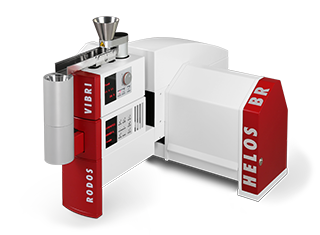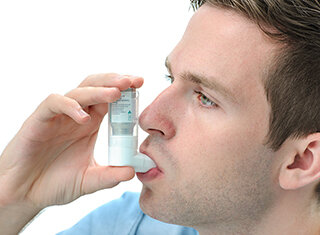Laser diffraction analysis of the discharge behaviour of inhalers and nebulisers with particles ranging from 0.25 µm to 875 µm
When combined with the modular INHALER adapter, the compact laser diffraction sensor HELOS/BR delivers time-resolved and reproducible analyses of the size distribution of droplet mists and solid aerosols with particles ranging from 0.25 µm to 875 µm. The modular layout of the INHALER adapter offers optimum options for flexible adaptation to a wide range of different pressurised metered dose inhalers (pMDI), dry powder inhalers (DPI), nebulisers or more recent developments such as superfine mist inhalers (Soft Mist™ Inhaler | SMI). In order to simulate different breathing profiles, measurements can be performed as a function of volumetric flow or pressure loss. The inhalation and measurement duration can be freely defined.
The central components of the INHALER comprise – alongside a base unit in which the other components are integrated – the measuring chamber and the software-controlled vacuum control unit, which ensures precise control of the volumetric flow. Nebulisers with slanting mouthpieces can be vertically aligned with a tilt compensation feature in the central unit. A large selection of system components allows the system to be adapted to different application conditions and further analysis requirements.
Inlet side | Before the measuring zone
- Mouthpiece – accurately fitting holders and mountings for applicators | individual mountings can be manufactured from silicone compound
- Extension cylinder – for adapting the distance between the mouthpiece and the measurement volume (spacer)
- 90° glass pipe bend – simulation of the throat, horizontal installation position also with pre-separator
- Pre-separator for DPIs – in order to separate the carrier material from the active ingredient component under measurement (Fine Particle Fraction | FPF)
Discharge side | After the measuring zone
- Venturi meter – for precise measurement of the air throughput
- Fine particle collector – for recovery of the active ingredient component from the air flow for further quantitative and qualitative analyses | Reliable separation with ultrafine separation at flow rates of up to 200 l/min
- Washing bottle – for recovery or separation of all particles at flow rates of up to 60 l/min
- Vacuum pump – for reliable generation of volumetric flows for the different flow rate and passage conditions required for in vitro simulations | Needle valve for precise control of the volumetric flow from 20 to 200 l/min
Typical measurements include all types of drug formulations for delivery to the lungs. The time-resolved measurement with up to 2,000 particle size distributions per second generates a sophisticated image of the dynamic discharge behaviour. The sample amounts that are to be measured vary depending on the field of interest and range from a few micrograms of the pure active ingredient to a few milligrams on dry powder formulations comprising active ingredient and carrier. The measurement of a single dose of an inhalant takes just a few seconds. But measurement times of several minutes, e.g. for prolonged inhalation of solutions with the aid of nebulisers, can also be achieved.
The vacuum pump simulates the breath being drawn and creates a vacuum in the INHALER system, which ensures a controlled flow of air. For inhalers with a low flow resistance (typically MDIs or nebulisers) the volumetric flow is determined and controlled via measurement of the differential pressure in the venturi nozzle. In the case of inhalers with a high flow resistance (typically DPIs), control is provided by measuring the absolute pressure. Both the volumetric flow and the ambient temperature, relative humidity and any tilting of the applicator are recorded for every measurement.
With an angled connection piece (induction port) it is possible to connect different types of cascade impactors downstream (e.g. Andersen Cascade Impactor (ACI), Next Generation Impactor (NGI)) in order to demonstrate the corresponding correlation between the methods.
- Particle and droplet size distribution
- For all types of inhalers and nebulisers
- For research, product development, quality control
- 4 high-resolution measuring ranges from 0.25 µm to 875 µm | R2 to R5T
- Time-resolved characterisation of the dispersion and discharge behaviour
- As a function of volumetric flow, pressure loss, flow geometry
- Modular system for adaptation to the relevant application
The system creates the best conditions for validating the results in a pharmaceutical context. HELOS & INHALER are used accordingly both for fundamental research applications and in product development, as well as in quality control.












